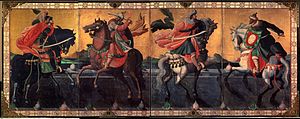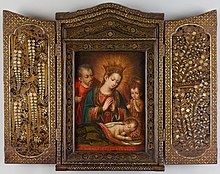247:
235:
223:
41:
57:
207:
20:
259:
171:
or folding screens are particularly notable, with over 90 pairs surviving to this day. These vibrant paintings depicted foreigners of all colors arriving in Japanese ports and walking in the streets of Japanese inland towns
246:
222:
206:
234:
138:, the word took on a new meaning when it came to designate the Portuguese, who first arrived in 1543, and later other Europeans. The term also refers to paintings which Europeans brought to
597:
523:
457:
408:
396:
40:
605:
665:
645:
553:
56:
364:
258:
189:
437:
569:
670:
52:
of c.1611-1614, Kobe City Museum. It is a work that fuses
Western themes and techniques with Japanese techniques.
172:(see figure 1). Another popular subject within Nanban art was the depiction of foreign warriors. Artists of the
601:
334:
628:
188:
and alternative materials and techniques, appear to have had little lasting influence in Japan. Given the
117:
69:
660:
479:
228:
Hasegawa
Nobukata painting of a religious man with children. Edo period, early 17th century.
287:
213:
61:
282:
in the 1850s and the 1860s, there is evidence of earlier
Japanese influence in the art of
8:
291:
135:
519:
359:
193:
185:
636:
19:
641:
549:
501:
433:
252:
Hasegawa
Nobukata painting of two "Western warriors." Edo period, early 17th century.
200:, which largely closed Japan to foreign contact from the 1630s, Nanban art declined.
181:
491:
453:
329:
65:
34:
309:
283:
131:
173:
30:
654:
505:
349:
105:
88:
91:
of the sixteenth and seventeenth centuries influenced by contact with the
429:
177:
496:
354:
127:
109:
480:""Mōko Shūrai Ekotoba" (Illustrated Account of the Mongol Invasions)"
279:
369:
317:
275:
113:
159:
48:
25:
308:. This was derived from the trade in Japanese crafts through the
150:
Nanban art developed after the first
Portuguese ships arrived in
374:
313:
197:
151:
122:
303:
155:
139:
637:
Obras-primas dos biombos Nanban, Japão-Portugal século XVII
576:
323:
240:
Screen painting of foreign ship and
Europeans in Japan.
543:
423:
290:influenced pre-Hispanic lacquerware resulting in
16:Japanese art genre of the 16th and 17th centuries
652:
184:. Canons of western art of the period, such as
524:Japanese Architecture and Art Net Users System
458:Japanese Architecture and Art Net Users System
301:
192:from the end of the sixteenth century and the
164:
97:
80:
295:
212:Painting from Momoyama period (1573-1615) by
392:
390:
278:did not develop in the west until after the
216:of a European woman playing a viola de mano.
64:produced and exported at the request of the
190:persecution and prohibition of Christianity
495:
387:
180:in combining foreign subject matter with
126:, originally referring to the peoples of
419:
417:
264:Namban art, screen painting, circa 1600.
158:and other objects were produced, Nanban
68:. Azuchi–Momoyama period, 16th century,
55:
39:
18:
631:, Chandeigne, 2015 (978-2-36732-121-9)
478:Testa, Giuseppina Aurora (2020-07-03).
653:
324:Museums with collections of Nanban art
512:
477:
414:
269:
365:Japanese words of Portuguese origin
13:
629:Nanban Folding Screen Masterpieces
112:from Europe and specifically from
14:
682:
598:"Biombos Namban (Namban screens)"
257:
245:
233:
221:
205:
546:Namban: Art in Viceregal Mexico
590:
562:
537:
471:
446:
402:
1:
602:Museu Nacional de Arte Antiga
544:Lake, Rodrigo Rivero (2006).
380:
335:Museu Nacional de Arte Antiga
29:of c.1570-1616 attributed to
320:(Mexico) from 1565 to 1815.
176:were joined by those of the
7:
424:Okamoto, Yoshitomo (1972).
343:
302:
182:Japanese styles of painting
10:
687:
570:"Kobe City Museum e-guide"
145:
104:or 'Southern barbarians',
45:Western Kings on Horseback
312:, which traveled between
296:
165:
154:in 1543. While Christian
98:
81:
666:Japan–Portugal relations
634:(pt) Alexandra Curvelo,
627:(en) Alexandra Curvelo,
339:Museu do Oriente, Lisbon
671:History of art in Japan
426:The Namban Art of Japan
72:
70:Kyushu National Museum
53:
37:
59:
43:
22:
640:, Chandeigne, 2015 (
288:Japanese lacquerware
62:Japanese lacquerware
292:Mexican lacquerware
136:Nanban trade period
497:10.5209/eiko.73275
360:Hasekura Tsunenaga
280:reopening of Japan
186:linear perspective
118:Sino-Japanese word
73:
54:
38:
646:978-2-36732-120-2
555:978-84-7506-693-6
316:(Philippines) to
270:Reverse influence
214:Hasegawa Nobukata
678:
618:
617:
615:
613:
604:. Archived from
594:
588:
587:
585:
583:
574:
566:
560:
559:
541:
535:
534:
532:
530:
516:
510:
509:
499:
475:
469:
468:
466:
464:
450:
444:
443:
421:
412:
411:Kobe City Museum
406:
400:
399:Kobe City Museum
394:
330:Kobe City Museum
307:
300:, from Japanese
299:
261:
249:
237:
225:
209:
170:
168:
167:
103:
101:
100:
86:
84:
83:
66:Society of Jesus
35:Kobe City Museum
686:
685:
681:
680:
679:
677:
676:
675:
651:
650:
622:
621:
611:
609:
596:
595:
591:
581:
579:
572:
568:
567:
563:
556:
542:
538:
528:
526:
520:"Nanban-byoubu"
518:
517:
513:
476:
472:
462:
460:
452:
451:
447:
440:
422:
415:
407:
403:
395:
388:
383:
346:
326:
310:Manila Galleons
284:Colonial Mexico
272:
265:
262:
253:
250:
241:
238:
229:
226:
217:
210:
162:
148:
95:
78:
17:
12:
11:
5:
684:
674:
673:
668:
663:
620:
619:
608:on 20 May 2011
589:
561:
554:
536:
511:
470:
445:
438:
413:
401:
385:
384:
382:
379:
378:
377:
372:
367:
362:
357:
352:
345:
342:
341:
340:
337:
332:
325:
322:
271:
268:
267:
266:
263:
256:
254:
251:
244:
242:
239:
232:
230:
227:
220:
218:
211:
204:
147:
144:
134:. During the
132:Southeast Asia
15:
9:
6:
4:
3:
2:
683:
672:
669:
667:
664:
662:
659:
658:
656:
649:
647:
643:
639:
638:
632:
630:
625:
624:bibliography
607:
603:
599:
593:
578:
571:
565:
557:
551:
547:
540:
525:
521:
515:
507:
503:
498:
493:
489:
485:
484:Eikón / Imago
481:
474:
459:
455:
449:
441:
439:0-8348-1008-5
435:
431:
427:
420:
418:
410:
405:
398:
393:
391:
386:
376:
373:
371:
368:
366:
363:
361:
358:
356:
353:
351:
348:
347:
338:
336:
333:
331:
328:
327:
321:
319:
315:
311:
306:
305:
298:
293:
289:
285:
281:
277:
260:
255:
248:
243:
236:
231:
224:
219:
215:
208:
203:
202:
201:
199:
195:
191:
187:
183:
179:
175:
161:
157:
153:
143:
141:
137:
133:
129:
125:
124:
119:
115:
111:
107:
94:
90:
77:
71:
67:
63:
58:
51:
50:
46:
42:
36:
32:
28:
27:
21:
661:Japanese art
635:
633:
626:
623:
610:. Retrieved
606:the original
592:
580:. Retrieved
564:
545:
539:
527:. Retrieved
514:
487:
483:
473:
461:. Retrieved
448:
425:
404:
350:Nanban trade
273:
149:
121:
110:missionaries
92:
89:Japanese art
75:
74:
47:
44:
24:
430:Weatherhill
178:Tosa school
174:Kanō school
31:Kanō Naizen
655:Categories
548:. Turner.
454:"Nanban-e"
381:References
355:Kirishitan
196:policy of
128:South Asia
120:, Chinese
116:. It is a
87:refers to
76:Nanban art
577:Kobe City
506:2254-8718
490:: 35–57.
612:28 March
582:28 March
529:28 March
463:28 March
370:Yamato-e
344:See also
318:Acapulco
276:Japonism
194:Tokugawa
114:Portugal
409:泰西王侯騎馬図
146:History
106:traders
23:Nanban
644:
552:
504:
436:
375:Nanman
314:Manila
274:While
198:sakoku
152:Kyushu
123:Nánmán
93:Nanban
573:(PDF)
304:makie
297:maque
160:byōbu
156:icons
140:Japan
49:byōbu
26:byōbu
642:ISBN
614:2011
584:2011
550:ISBN
531:2011
502:ISSN
465:2011
434:ISBN
397:南蛮屏風
166:南蛮屏風
130:and
108:and
82:南蛮美術
492:doi
294:or
657::
648:)
600:.
575:.
522:.
500:.
486:.
482:.
456:.
432:.
428:.
416:^
389:^
286:.
142:.
99:南蛮
60:A
33:,
616:.
586:.
558:.
533:.
508:.
494::
488:9
467:.
442:.
169:)
163:(
102:)
96:(
85:)
79:(
Text is available under the Creative Commons Attribution-ShareAlike License. Additional terms may apply.


